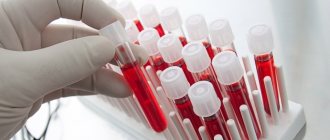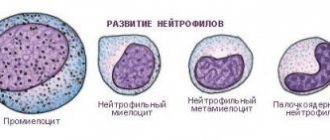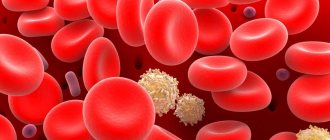Role of plasma cells
Plasma cells are among the leukocytes - white blood cells responsible for immunity. Their main task is the production of immunoglobulins or antibodies. They are formed when the body is attacked by bacteria, viruses, toxins, everything that poses a danger to children and adults. Such foreign substances are called antigens.
Note! Antibodies produced by plasma cells are the body's immune response to the danger that has arisen. They attach to antigens and prevent them from harming the body, and also contribute to the destruction of foreign agents.
Most often, plasma cells are found in lymph nodes, concentrated in the spleen, and fixed in the red bone marrow. In the latter case, they influence the formation of stable, most often lifelong, immunity to certain diseases. Cells remember a dangerous substance; the next time they encounter it, they won’t have to recognize it, so it can be destroyed much faster and easier.
The appearance of plasma cells in the child’s blood
Lymphocytes are converted into plasma cells if the body is under threat. When an antigen penetrates it, a signal is sent to the brain warning of danger. Group B lymphocytes, essential for the formation of immunity, are concentrated in the lymph nodes, activated, and later converted into plasma cells.
It turns out that plasma cells are transformed B-lymphocytes, some of which become active, which is a necessary condition for eliminating the threat to health:
- Some produce antibodies that fight the harmful agent;
- Others turn into memory cells. They are necessary if the same antigen enters the body again. Then they give a signal, and the fight against the dangerous substance begins. Immune memory works for months or many years. Sometimes it persists until the end of life. The plasma cells themselves die quite quickly; after 2-3 days they are not detected in the blood.
Normal blood test values
In an adult, plasma cells should not be seen during a blood test. Their detection indicates a pathology, the cause of which must be immediately established. For children the situation is somewhat different:
- It is considered normal for newborns if there are plasma cells, but their number does not exceed 2% of the total volume of other cells;
- In older children, single similar cells may be observed. So, if there is one plasma cell per 200-400 leukocytes, this is not considered a pathology.
Doctors always recommend retaking the blood test and then, if necessary, prescribe additional examinations. The presence of plasma cells can be detected using a general blood test. The material is collected from a finger, preferably on an empty stomach, so as not to affect the reliability of the results.
Collection of material for analysis
The main thing is that the child is not tired or exhausted; care must be taken that he does not scream or cry. Even emotional experiences can change the outcome. The doctor examines the test results and, if abnormalities are detected, finds out the cause. Only a specialist can understand whether the values are normal or whether the baby needs drug therapy.
Plasma cells in a general blood test: causes and treatment
Plasma cells are a unique weapon of the immune system that waits in the wings before foreign particles invade the body. As soon as a signal is received about the appearance of a bacteria or virus, these cells begin to produce many antibodies to neutralize the harmful object.
The mechanism of appearance of plasma cells
The function of plasma cells is protective
Unlike other immune cells, plasma cells are not constantly present in the blood. They are contained mainly in lymphatic tissues, spleen and bone marrow, leaving their shelters only in case of danger to the body. Their main function is the production of antibodies.
The mechanism of appearance occurs as follows:
- immune cells send a signal to the brain that pathogenic organisms of a certain type have invaded;
- the brain sends a signal to B lymphocytes with information about which particular virus or bacterium has penetrated;
- B lymphocytes move to the lymph nodes, where they transform into plasmocytes (plasma cells) to fight a specific pathogen;
- Plasmocytes begin to develop an immune response, forming several thousand molecules of protein compounds—antibodies—in a second.
During the transformation of B lymphocytes, some of the newly formed cells become so-called memory cells. They live for decades in the bone marrow, carrying antibodies against every bacteria or virus. Plasmocytes die within a few days after their birth.
Causes of plasma cells in blood tests
Infection of the body can lead to the appearance of plasma cells
Thus, plasma cells appear in the bloodstream only when it is necessary to produce antibodies. In the absence of a pathogenic factor, there is no need for plasma cells. If transformed B lymphocytes are found in a blood sample, then an infection is present in the body, or has been present in the recent past.
Factors that provoke the formation of plasma cells:
- flu,
- ORZ,
- ARVI,
- bacterial infection
- infectious diseases,
- mononucleosis,
- tuberculosis,
- dysbacteriosis,
- pathologies of an autoimmune nature,
- oncological tissue lesions.
When is the presence of plasma cells normal?
Plasmocytes may circulate for some time after infection
In a healthy adult, plasma cells should not be present in the bloodstream. They can appear in a ratio of 1-2 per 1000 leukocytes, so they are most often not detected when diagnosing a blood sample.
After the disease, transformed cells continue to circulate in the plasma for some time. Therefore, if plasma cells are detected, it is necessary to retake the test after a few days.
For children, the presence of a small percentage of plasma cells is normal. From the 5th day of life until the end of puberty, the blood may contain from 0.25 to 0.5% plasma cells. The percentage is calculated in relation to the total number of leukocytes.
Plasmocyte detection test
The plasma cell test requires minimal preparation
The doctor may refer you for an analysis to detect plasma cells if the patient is concerned about various ailments: aching joints, lethargy, causeless fatigue, low-grade fever, pain in the abdomen, swollen lymph nodes.
Plasmocytes are detected during a general blood test. Most often, a blood sample is taken from a finger, less often from a vein. Before blood collection, it is recommended not to eat for 8 hours.
If the analysis reveals the presence of plasma cells, it is necessary to undergo additional examinations to determine the cause. Only after this the doctor prescribes treatment.
Factors influencing the result
Plasmocytes in a blood sample in children are not uncommon.
The presence of plasma cells in adults is a clear sign of a pathological process in the body. If the acute stage of the disease is not observed, the doctor may suspect a sluggish chronic infection, which may not manifest itself in any way externally. Subsequent research will reveal the factor that influenced the appearance of plasma cells.
In children, the immune system is just developing, encountering many viruses, fungi and bacteria. To create lasting immunity for life, white blood cells actively develop a response to every dangerous object. Plasmocytes can always be detected in a child’s blood sample. Therefore, the patient's age is one of the factors influencing the result.
An increase in the number of transformed cells is detected after vaccination. It is with the help of plasma cells and memory cells that an immune response is formed to virus particles introduced into the body, which allows the cells to fight back this virus in the future.
Threat of presence of plasma cells
Blood smear from a patient with plasmacytoma
The presence of plasma cells in itself is a consequence of the inflammatory process in the body. If the pathogenic cause is eliminated, the cells will no longer circulate in the blood. However, under the influence of certain factors, plasma cells can form incorrectly and turn from friends of the immune system into its enemies.
This phenomenon is the most common concern of patients who receive a form about the content of plasma cells in the blood.
The idea that all plasma cells pose a threat and are an indicator of oncological changes in the blood is erroneous.
Such a failure at one of the stages of transformation of a B-lymphocyte into a plasma cell occurs in rare cases; a possible cause may be toxic damage to the body, exposure to radiation, or genetic disorders.
As a result of the failure, an atypical plasma cell appears, which, through continuous division, forms a plasmacytoma. The neoplasm is a malignant tumor of plasma cells and poses a danger to human life.
Increase in plasma cells
Detection of plasma cells in a child’s blood above the established norm may indicate the development of one of the following diseases:
- Viral infection, for example, measles, rubella, chickenpox, mononucleosis;
- Autoimmune disorders;
- Tuberculosis;
- Streptococcal infections. They represent a group of pathologies; it is not always possible to immediately determine the cause of the ailment. Scarlet fever is caused only by streptococci, so at the first sign the doctor prescribes the necessary antibiotics. With inflammatory processes in the throat, it is impossible to find out from a blood test what exactly triggered the disease. Most often, children have streptococcal tonsillitis;
- Staphylococcal infections. As a result of the bacteria entering the body, a number of symptoms appear, in particular, diarrhea, nausea and vomiting. The child becomes lethargic and refuses to eat. Staphylococcus can affect the mouth, throat, skin, and genitourinary system;
- Flu;
- Fungal infections;
- ARVI.
The higher the indicator value, the more dangerous the pathological process. Only a doctor can determine the reason for the increase. He will evaluate all the indicators in the resulting analysis together, examine the child; his well-being and the presence of additional symptoms are of great importance. If this is not enough to make a diagnosis, the necessary additional studies will be carried out.
Note! Most often, plasma cells grow in children during colds, as well as viral infections that children usually suffer from: measles, rubella and chickenpox.

Chickenpox in a child
The reading may remain elevated for several days. Even after complete recovery, cells may be visible in a blood test. They quickly die and everything returns to normal. If, during a retake, a high value of the studied indicator is again observed, this indicates pathology.
In children, immunity is just developing, constantly encountering various infections. That is why a slight presence of plasma cells in the blood is considered normal. They can also appear after vaccination, this indicates that immune protection has appeared and will begin to work when a threat to the body arises. Therefore, when 1 or 2 plasma cells out of 400 others are found in a child’s blood, this does not mean that a pathological process is taking place. You just need to undergo an examination after a few days to make sure that the value of the indicator does not increase.
Blood analysis in children: why plasma cells are found in it
Plasma cells should not be present in the blood of adults; their presence is allowed in children.
A few units may be detected even in the absence of a threat from infections. Child
Role of plasma cells
Plasma cells are among the leukocytes - white blood cells responsible for immunity. Their main task is the production of immunoglobulins or antibodies. They are formed when the body is attacked by bacteria, viruses, toxins, everything that poses a danger to children and adults. Such foreign substances are called antigens.
Note! Antibodies produced by plasma cells are the body's immune response to the danger that has arisen. They attach to antigens and prevent them from harming the body, and also contribute to the destruction of foreign agents.
Most often, plasma cells are found in lymph nodes, concentrated in the spleen, and fixed in the red bone marrow.
In the latter case, they influence the formation of stable, most often lifelong, immunity to certain diseases.
Cells remember a dangerous substance; the next time they encounter it, they won’t have to recognize it, so it can be destroyed much faster and easier.
The appearance of plasma cells in the child’s blood
How to make a child poop for analysis
Lymphocytes are converted into plasma cells if the body is under threat. When an antigen penetrates it, a signal is sent to the brain warning of danger. Group B lymphocytes, essential for the formation of immunity, are concentrated in the lymph nodes, activated, and later converted into plasma cells.
It turns out that plasma cells are transformed B-lymphocytes, some of which become active, which is a necessary condition for eliminating the threat to health:
- Some produce antibodies that fight the harmful agent;
- Others turn into memory cells. They are necessary if the same antigen enters the body again. Then they give a signal, and the fight against the dangerous substance begins. Immune memory works for months or many years. Sometimes it persists until the end of life. The plasma cells themselves die quite quickly; after 2-3 days they are not detected in the blood.
Normal blood test values
Blood type of a child from his parents - table
In an adult, plasma cells should not be seen during a blood test. Their detection indicates a pathology, the cause of which must be immediately established. For children the situation is somewhat different:
- It is considered normal for newborns if there are plasma cells, but their number does not exceed 2% of the total volume of other cells;
- In older children, single similar cells may be observed. So, if there is one plasma cell per 200-400 leukocytes, this is not considered a pathology.
Doctors always recommend retaking the blood test and then, if necessary, prescribe additional examinations. The presence of plasma cells can be detected using a general blood test. The material is collected from a finger, preferably on an empty stomach, so as not to affect the reliability of the results.
Collection of material for analysis
The main thing is that the child is not tired or exhausted; care must be taken that he does not scream or cry. Even emotional experiences can change the outcome. The doctor examines the test results and, if abnormalities are detected, finds out the cause. Only a specialist can understand whether the values are normal or whether the baby needs drug therapy.
Increase in plasma cells
Detection of plasma cells in a child’s blood above the established norm may indicate the development of one of the following diseases:
- Viral infection, for example, measles, rubella, chickenpox, mononucleosis;
- Autoimmune disorders;
- Tuberculosis;
- Streptococcal infections. They represent a group of pathologies; it is not always possible to immediately determine the cause of the ailment. Scarlet fever is caused only by streptococci, so at the first sign the doctor prescribes the necessary antibiotics. With inflammatory processes in the throat, it is impossible to find out from a blood test what exactly triggered the disease. Most often, children have streptococcal tonsillitis;
- Staphylococcal infections. As a result of the bacteria entering the body, a number of symptoms appear, in particular, diarrhea, nausea and vomiting. The child becomes lethargic and refuses to eat. Staphylococcus can affect the mouth, throat, skin, and genitourinary system;
- Flu;
- Fungal infections;
- ARVI.
How to make a child pee for analysis, the best ways to collect urine
The higher the indicator value, the more dangerous the pathological process. Only a doctor can determine the reason for the increase. He will evaluate all the indicators in the resulting analysis together, examine the child; his well-being and the presence of additional symptoms are of great importance. If this is not enough to make a diagnosis, the necessary additional studies will be carried out.
Note! Most often, plasma cells grow in children during colds, as well as viral infections that children usually suffer from: measles, rubella and chickenpox.
Chickenpox in a child
The reading may remain elevated for several days. Even after complete recovery, cells may be visible in a blood test. They quickly die and everything returns to normal. If, during a retake, a high value of the studied indicator is again observed, this indicates pathology.
In children, immunity is just developing, constantly encountering various infections. That is why a slight presence of plasma cells in the blood is considered normal.
They can also appear after vaccination, this indicates that immune protection has appeared and will begin to work when a threat to the body arises.
Therefore, when 1 or 2 plasma cells out of 400 others are found in a child’s blood, this does not mean that a pathological process is taking place. You just need to undergo an examination after a few days to make sure that the value of the indicator does not increase.
Additional diagnostic methods
To determine the number of plasma cells in the blood, blood is taken from a finger prick. This is the simplest and most inexpensive test to assess the child’s condition. Based on the results, you can understand from which side the threat came; they are attacking the body, for example, viruses or bacteria.
If all indicators are normal, then additional research is needed to establish the cause of the pathological condition. Blood from a vein is also examined, but in children it is much more difficult to collect blood. In addition, this is a lot of stress for the child.
Therefore, they try to make do with capillary blood.
The causative agent of the disease can be identified using the PCR method. Laboratory assistants take a sample from the collected material and use special enzymes to copy DNA and RNA. Even if the disease has just begun, the method allows it to be detected. He will also notice several molecules of a dangerous pathogen in the absence of alarming symptoms.
Dangers and Consequences
With timely treatment of infectious pathologies, it is easy to avoid dangerous consequences. It’s not scary if several plasma cells are observed during illness and illness. They may remain for two to three days after symptoms disappear.
This only confirms the presence of a dangerous agent and the fight of the immune system against it. If during the retake all indicators are normal, then there is no need to worry, the inflammation has been eliminated. When deviations are detected again, the cause must be found.
Otherwise, infectious processes can develop into chronic ones, which will affect the quality of life of the child and his parents.
Note! There is no need to self-medicate; in deciphering tests and making a diagnosis, you need to trust a specialist. You should not take antibiotics or other medications on your own. Only a doctor determines the advisability of prescribing them and selects the required dosage.
Child at a doctor's appointment
The higher the content of plasma cells, the more dangerous the condition and the higher the threat to the health and life of the child. It’s bad when there are no symptoms, such as sore throat, fever or rash, and the baby has not been sick in recent days.
In this case, the presence of cells from a number of leukocytes, especially if they have a large percentage in the total number of others, may indicate the occurrence of serious diseases that require immediate medical attention.
Plasma cells may always be present in a child’s blood. It is not considered pathological if several units are detected. The imperfect immunity of children is formed by adapting to the world and many infections, therefore plasma cells remain active, working to protect the body.
Source: https://kpoxa.info/zdorovie-pitanie/plazmaticheskie-kletki-krovi-rebenka.html
Additional diagnostic methods
To determine the number of plasma cells in the blood, blood is taken from a finger prick. This is the simplest and most inexpensive test to assess the child’s condition. Based on the results, you can understand from which side the threat came; they are attacking the body, for example, viruses or bacteria. If all indicators are normal, then additional research is needed to establish the cause of the pathological condition. Blood from a vein is also examined, but in children it is much more difficult to collect blood. In addition, this is a lot of stress for the child. Therefore, they try to make do with capillary blood.
The causative agent of the disease can be identified using the PCR method. Laboratory assistants take a sample from the collected material and use special enzymes to copy DNA and RNA. Even if the disease has just begun, the method allows it to be detected. He will also notice several molecules of a dangerous pathogen in the absence of alarming symptoms.
Principle of analysis and norm indicators
To conduct a plasma cell test, no additional preparation is required. The patient only needs to follow generally accepted recommendations, which must first be clarified with the medical staff. As mentioned above, the number of plasma cells is calculated when carrying out the total, or, as it is also called. clinical blood test.

Blood sampling from a child for testing should be done once every six months.
The basic rules that must be followed by those undergoing this procedure include the following:
- visit the laboratory to submit biomaterial in the morning or early afternoon;
- refrain from eating for breakfast, and dinner should be no later than 20.00 the evening before the analysis;
- try not to overwork physically and psycho-emotionally, as this may negatively affect the results of the study.
The biomaterial is collected from a finger, that is, peripheral blood is taken for research. To take it, a puncture is performed with a sterile scarifier and a few drops are taken into a special test tube, which will be enough for diagnostics.
The sample is then labeled and sent for microscopic examination to the laboratory. The results will most often be known the next business day, but this may also depend on the workload of the laboratory.
In a situation where research materials are required as soon as possible, it is worth contacting a private clinic, where, for a fee, the analysis will be deciphered in 1–2 hours, and the patient will receive the necessary information as quickly as possible.
If plasma cells are detected in the blood of an adult, we can confidently say about a pathological process. In this case, the doctor needs to figure out whether the disease is in the active phase of development or whether it is residual effects of a previous pathology.
Dangers and Consequences
With timely treatment of infectious pathologies, it is easy to avoid dangerous consequences. It’s not scary if several plasma cells are observed during illness and illness. They may remain for two to three days after symptoms disappear. This only confirms the presence of a dangerous agent and the fight of the immune system against it. If during the retake all indicators are normal, then there is no need to worry, the inflammation has been eliminated. When deviations are detected again, the cause must be found. Otherwise, infectious processes can develop into chronic ones, which will affect the quality of life of the child and his parents.
Note! There is no need to self-medicate; in deciphering tests and making a diagnosis, you need to trust a specialist. You should not take antibiotics or other medications on your own. Only a doctor determines the advisability of prescribing them and selects the required dosage.

Child at a doctor's appointment
The higher the content of plasma cells, the more dangerous the condition and the higher the threat to the health and life of the child. It’s bad when there are no symptoms, such as sore throat, fever or rash, and the baby has not been sick in recent days. In this case, the presence of cells from a number of leukocytes, especially if they have a large percentage in the total number of others, may indicate the occurrence of serious diseases that require immediate medical attention.
Plasma cells may always be present in a child’s blood. It is not considered pathological if several units are detected. The imperfect immunity of children is formed by adapting to the world and many infections, therefore plasma cells remain active, working to protect the body.
Research to identify the indicator
When an analysis and a comprehensive study is carried out, the test result is transferred from the laboratory to a specialist who observes the patient. The doctor qualitatively deciphers the results, finds out whether the indicators are normal and what needs to be done if the indicator deviates. Prescribes the necessary treatment to reduce the number of plasma cells. And then he treats the disease that has been identified. When plasma cells are detected in the blood, this is the main reason that the infectious process has progressed in the body.
When the result of the analysis is deciphered, the specialist prescribes a comprehensive diagnosis in order to find out the exact cause of the abnormal process. It is also important that the doctor checks for signs of diseases such as measles, rubella, meningitis, and leukemia. Timely treatment measures eliminate health problems. When infectious mononucleosis has formed in the body, the plasma cell level also increases. Mononucleosis without treatment with the necessary type of medications forms severe processes in the system that have a detrimental effect on human health.
Using a procedure such as a blood test, possible developments of malignant processes and tumors are identified. Due to the plasma cell content, it helps to eliminate the disease in a timely manner. A plasma cell is a part of the body's immune system that produces specific immunoglobulins and antibodies. Plasma cells live for a couple of days, and a memory cell a little longer, and some types even persist for life in the human body with repeated invasions of the same antigens. This cell begins to fight it, and antibodies are synthesized in large quantities. All this is easily recognized during analysis.
The normal indicator in the blood system is the absence of plasma cells. In a child, they are contained in the form of a single plasma cell. Plasma cell appears in the blood system when there is a viral infection in the body.
Plasma cells in the blood: The motor activity of the cell depends on stopping the formation of high concentrations of antibody protein at the site where the antigen is processed. When antibodies are in excess, in short periods of time they eliminate antigens and turn off immune responses in the body system. Plasma cells in a general blood test: plasma cells are concentrated directly in the bone marrow system and the norm is their absence in the blood system.
Plasma cells in a blood test: in a pathological process, they are detected during a clinical analysis in the blood system in children and adults. Often, this means the presence of a complex disease in the body’s system, when the disease is viral in nature, a pathological process in the system due to ionizing radiation, and also when the patient has a cancerous tumor (in the blood of a child). The plasma cell is an important component in the leukocyte formula. When it is detected in the blood, it is determined what type of disease has occurred in the body system (plasma indicator). The main role of such cells is to protect the system from the effects of infectious and bacterial viruses.
Plasmocytes (plasma cells) are a class of leukocytes that are formed from B-lymphocytes, the main function of which is the production of specific antibodies (immunoglobulins). Plasmocytes in the blood (plasma cells) are activated B lymphocytes that are capable of synthesizing antibodies specific to one specific antigen.










